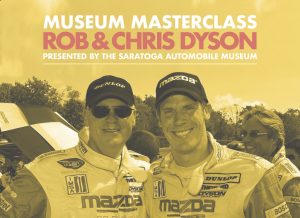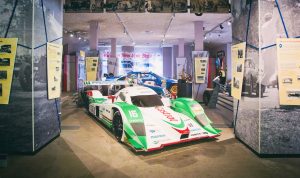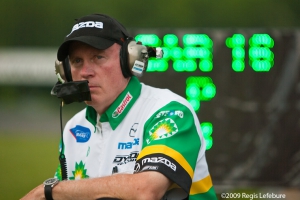What used to be common is now uncommon. You see far fewer engine failures on the race track than you use to. We put the question of “Why?” to Andrew Saunders, Engineering Manager of Advanced Engine Research (AER). AER designed, developed and services the Mazda MZR-R 2.0 liter, four-cylinder turbo engine that powers the Dyson Racing American Le Mans Series P1 entries. AER-built turbo engines have powered Dyson’s LMP cars for eight of the past ten seasons. The enhanced reliability comes from improvements in four main areas: the failsafe mechanisms that protect today’s engines, advances in computer-aided design, modern metallurgy, and dyno reliability testing. In the first part of this interview, we went over failsafe mechanisms and now in this last part, we cover the other advances which have led to longer-lived engines.
The race fan sees far fewer spectacular engine blow-ups than they us to. How much is that better technology and materials and how much is the built in fail-safe mechanisms?
I would say it is a reasonable split. The level of expertise in building engines, the metallurgy, and the effort that goes into making the engine correct off the drawing board, is much better now than it has been in the past. Historically, it would have been collecting all the components to build an engine, do some finger in the air calculations and then design your engine. Now you start with an engine that should work well from its initial design and you can go into a dyno program to make sure the engine works under all conditions. Before a Formula One engine ever gets to the track it will have done thousands and thousands of kilometers of reliability running.
What else makes engines more reliable in racing today?
As a result of aerospace and industry advances, better metals and materials are freely available, and compared to 20 or 30 years ago, at comparatively low cost. So you can afford to put good quality materials into “lower end” racing engines: they are not as exclusive as they once were. A good example is DLC (Diamond Like Carbon) coatings which were the domain of Formula One ten years ago. We can now DLC coat camshafts and camshaft followers and it removes almost all the friction. You can have low friction coating on your valves and pump shafts for example, plus we have low friction coatings seals with PTF (Teflon) lips on them rather than just rubber. What was once the domain of aerospace and F1 are now freely available to all levels of motorsports.
The other thing that has improved is reliability testing. In the past, you ran the engine in the car till it broke, worked out why it broke, and then made a stronger part. It used to be quite literally back of a cigarette pack type of calculations. Whereas now, almost all engine design companies are using the cad package CATIA. Most people in motorsport engine manufacturing use it along with chassis manufacturing as well. It has built in FEA (Finite Element Analysis) so before you have a single rod made or a single crank, you can actually analyze it if it is going to break or not. You do not have to go through the pain of making something that may end up lasting only five minutes. Most things that are manufactured and produced are close to the finished product. We use 1D modeling for performance development, and CFD (Computational Fluid Dynamics) for gas and fluid flow in combustion chambers and ports. A long time before anything is forged or machined or cast, you have a very good idea if your engine is going to fundamentally work or not. And that carries over into the quality of the engine. For example, machining tolerances: having a CNC (Computer Numerical Control) machine that is accurate to five microns is common place now. You only have to go back twenty years when buying a new car required that you had to run it in. You do not break in new cars anymore; you get in them and drive them. That is basically because the standard tolerances in engineering are so much higher today.
Testing and simulation?
Once again, you have so many more sensors available to you today. For example, in measuring pressures in the cylinder is standard today. You also have mobile piston crown temperature sensors so you can actually measure your crown temperature using radio wave sensors. You have sensors that can establish if you have torsional vibration in the engine. So you can determine if you have any deficiencies in the engine at numerous levels and deal with it at the early stages.
How does dyno testing add to the reliability equation?
There are several stages of dyno testing. At the very early stages, you can rig test individual components. For example, to develop your valve train, you would have a head rig with a Perspex cam cover so you could see what is going on and you would run that and develop your valve train and make sure you do not have valve bounce and make sure you do not wipe cam noses or have any other kinds of damage. The lists of things that you can rig test are endless. That is one example. You can also have a pump rig, a head rig, and various other rigs to test parts of the engine in isolation.
Another level of testing is the single cylinder model. When you are trying to develop your engine in the initial stages, it is very cost effective to develop a single cylinder and measure the effects of that cylinder. So larger engine companies have a series of single cylinder dynos and create single cylinder versions of the engine.
The next stage after that is a steady-state dyno where you run tests on the engine at fixed RPMs and you can run to a schedule. So you ramp-up from RPM to RPM and simulate transient running to a certain degree or just spend extended periods of time at RPM levels to test the duty of the engine at those levels. For example, if you took a lap of Le Mans and did a histogram of the times spent at various throttle positions, engine RPM levels, and engine load levels, you could multiply that by a stint and multiply that by 24 hours and then divide it back into rpm load levels, so theoretically, you could prove your engine out in terms of distance alone on a steady-state dyno – X minutes of 8,000 rpms 50 per cent throttle, etc. and write a schedule to test that. Ultimately, that is not the real thing so the next step is transient running where you actually have a model of a lap of the circuit. F1 companies typically use Monza for wide open throttle time and Spa for a more generic circuit. In sports car racing, at AER for example, we have a model of Sebring, a model of Spa, and a model of Suzuka, and we can run these on the dyno and then you would set your dyno to run for a given distance. If you are trying to simulate Le Mans, you would target a minimum of a 36 hour test to give yourself a 50 per cent margin. Depending on the quality of your dyno and your budget, that will set how accurate your testing is. As an example, the dyno facility at AER does not have dynamic air speed. So we have a fixed speed air supply which does not represent the track since at the track, your car goes from 0 to 300 kph and our air is probably fixed in the region of 50 kph. The next step to a transient dyno with dynamic air. Typically only an F1 team or related engine company would have that kind of facility. Also the transient dyno testing that is done at AER is a simulated transient test. We can control to simulate load, but on the upshifts, you are tricking the dyno into slowing the engine down, and coordinate that with an engine cut off of some type, whereas on a true transient dyno, you would actually have the car gearbox doing shifts and you are a lot closer to simulating the whole car. So depending on where you are in motorsports, defines the quality of your dyno: whether it is a full transient dyno, a simulated transient dyno, or a steady-state dyno. You replicate as much as you can, but for example you cannot change the ambient pressure the day you are testing the engine. So if you know you are going racing in Salt Lake City, at 5,000 feet, you cannot simulate that very well. If your engine company is sitting on the Thames Estuary, and you are at sea level, than you are at sea level. You can modify the temperature, you can modify the air inlet to some degree, water temperature, and oil temperature. Certain conditions can be controlled for repeatability, but you come up with the best compensation you can for the things you cannot recreate.
As an example, how much work would be involved in doing a Sebring simulation on the Mazda AER engine?
To do a twelve-hour Sebring test represents a full week of engine build and a whole week of engine strip time, so you have a hundred hours of preparation and strip down plus the test itself. You have periodic inspections of the engine since you have the luxury of doing that. That is the advantage over a track test. At the track, if you have a problem half way through the test, you have to live with it, whereas on the dyno you can study your sensors and if there is something which does not look normal, you can stop and inspect. So typically a twelve-hour test could take two or three days of running time which would mean two or three personnel to make sure the test is properly supported.
This is all very high tech. So the days of making engines by the seat of the pants are a thing of the past? Could anyone open an engine shop if they had enough money?
Theoretically, but you need the practicality of knowledge. It is a balance of the technology and using that technology with experience. Ultimately, there is still no substitute for experience. For example, if you were to set up a brand new engine shop and hire a whole raft of geniuses with all the computer tools in the world, it is very likely they would design in lots of teething problems in your new engine. That would not happen if you had experienced engine people with hands-on expertise in your new company. Technology without experience only creates problems.


